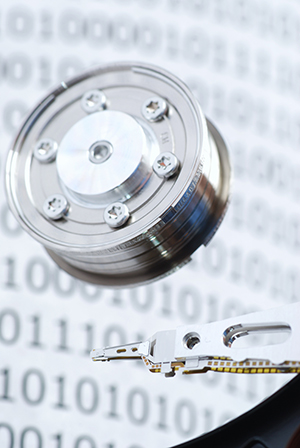
A three-layer sandwich of magnetic materials could help to pack more data onto hard drives.
© Zoonar/Thinkstock
A ‘sandwich’ of three iron alloy layers could help to create computer hard drives that can store more data than ever before. Tiejun Zhou and co-workers at the A*STAR Data Storage Institute in Singapore expect that their development, based on a new technology called heat-assisted magnetic recording (HAMR), could boost the capacity of disks.
Conventional hard drives contain a tiny electromagnet — a write head — that hovers over a spinning disk coated with a ferromagnetic material. The electromagnet induces the magnetic field within small regions of the disk to point either up or down, encoding one bit of data.
Heat can jumble these magnetic bits and destroy the data. The latest disks use materials with a very large coercivity — a measure of how difficult they are to demagnetize. However, write heads must exert even greater magnetic fields to encode data in such materials. The balance between bit size, coercivity and the electromagnet’s strength ultimately puts an upper limit on disk density of about 1 terabit per square inch.
In HAMR systems, each recording region is briefly heated above its Curie temperature, a point when magnetic coercivity drops significantly and a much smaller field can write the bit. Once the region cools, the coercivity rises and the bit locks into place.
Zhou’s team found a way to reduce both the writing temperature and the switching field in HAMR systems. The upper iron–platinum layer of the sandwich stores data bits; the lower iron–cobalt layer helps to channel the write head’s magnetic field, enabling data writing; and the middle iron–rhodium layer acts as a switch between the two. The middle layer is antiferromagnetic at room temperature so blocks any magnetic coupling between the other layers. At about 350 kelvin, however, it becomes ferromagnetic, allowing the layers to couple.
Iron–platinum normally has a Curie temperature of about 750 kelvin, but that plummets when coupled to the iron–cobalt layer. Data can therefore be written to the iron–platinum layer once the iron–rhodium layer becomes ferromagnetic, at about 350 kelvin.
Coupling also reduces the coercivity of the iron–platinum layer, so a write head would need only to generate one-third of the usual magnetic field to encode a bit. “Theoretically, the bit can occupy a space as small as 100 square nanometers,” says Zhou. The team now plans to reduce the size of the nanocrystals in each data region of the iron–platinum layer, while maintaining its high coercivity.
The A*STAR-affiliated researchers contributing to this research are from the Data Storage Institute.



